History of St. Chad's Catholic Primary School
St. Chad's Catholic School has been on this site since 1837. The two previous school buildings remain onsite (the cottage which have recently renovated) alongside the present school, a situation which we believe is unique.
The children are now taught in a bright, well equipped building, but passing the old buildings on their way to and from church each week for the school Mass makes them very aware of the school's beginnings.
In 1837 the Voluntary School was built (now the cottage next to the church). Fr. Tysen and his niece, Miss Catherine Attwood, educated up to 100 children there, with boys and girls taught separately. The school was established within the national education framework following the Education Act of 1870. Two teachers taught an average attendance of 68 children. An Inspector's report notes that the children were 'neat and orderly'.
Later Father Malfait raised enough money to have a 'new' Victorian school built which opened in1876, this was later used as the school dining Room.
Fr. John Kelly was subsequently appointed Rector. He cleared school debt through establishing a Donation's List, Bazaar and 'Sale of Work' to raise the required £500. However, staffing issues were a concern, with five headship changes in five years! This settled by 1900, by which point the school roll had reached 200. Now space was an issue! In 1904, improvement works were carried out, including partition of the main room and the supply of new furniture.
During the Second World War (1939 to 1945), the school struggled with overcrowding and curtailed staffing. By 1945 there were only four teachers for the 220 pupils in the 4 to 14 age group.
 The 1873 school. |
 An old photo of Dame School. |
|
 The Victorian school. |
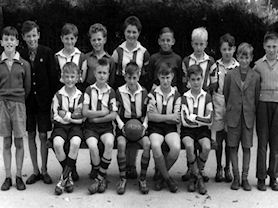 Football team c1950s. |
The numbers at St. Chad's, still an 'all-age' school, continued to rise, with overcrowding and cramped facilities proving problematic. An adverse HMI Report led to the purchase of the adjacent Marsh's Field and the commencement, in 1954, of works for the New School. This part, now the Reception and Key Stage 1 section, was blessed and opened in November 1957.
The photographs below were all taken on opening day 21 November 1957:
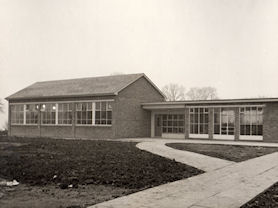 The New School on opening day. |
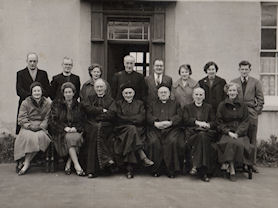 School staff on opening day. |
|
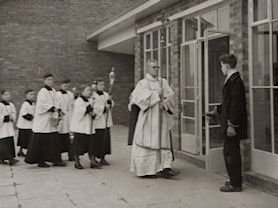 The opening and blessing. |
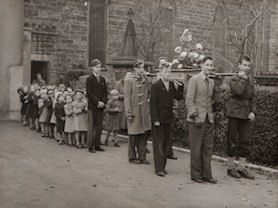 New statue being processed. |
|
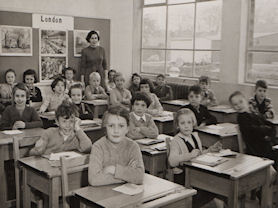 Some of the older children. |
 More older children. |
|
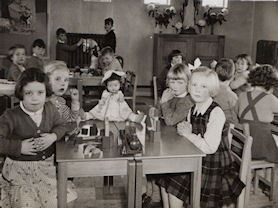 Some of the younger children. |
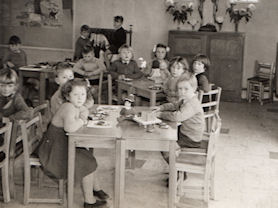 More younger children. |
|
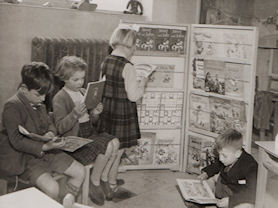 Reading Corner. |
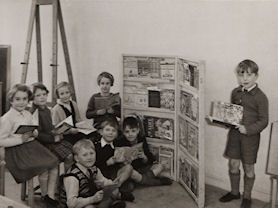 Children enjoying books. |
The New School building continued to grow, with construction of the Hall in 1962. After 1969, the old school became the Dining Room and mobile classrooms were installed.
Miss Walker was Headteacher of St. Chad's from 1941 until retiring in 1976, when she was replaced by Mrs Brooks. Miss Agnes Clarke, Deputy Headteacher and former pupil at the school, retired in 1973 after being presented with the Bene Merenti Medal in recognition of her work.
Mrs Brooks remained at St. Chad's until she retired in 1993, when Mrs DeMarco took over as Headteacher until her retirement in 2003, when Mrs Murphy started. She was head for four years when she left to become head of another Catholic primary school. Our next Headteacher, Mrs S Mason became head in 2007 and was herself once a pupil at St. Chad's. In 2020 Mr M Hinton became our Executive Headteacher, in 2022 Mrs K Bickley became Interim Principal, and in 2023 Mrs M Grubham took on the role of Executive Principal.
The school building continued to grow when the Junior Department added two classes in 1969 and a further two in 1973, along with various offices, toilets and workrooms. This provided enough room to accommodate the 210 children aged 4 to 11 on roll.
The main office in the school was extended in the late eighties to accommodate the newly arrived computer. A new office for the Headteacher's was completed in 2004.
October 2006 saw the opening of a new ICT Suite, Music/Technology Room, new Fiction Library Area and new Staff Room, providing much needed space and creating an extremely pleasant working environment for the children and the staff.
In April 2010 further building work took place. This time the building included new toilets for Key Stage 1 boys and girls, a new early years library/work area, a shower, a second disabled toilet, new female staff toilets and The Sunshine Room. The Sunshine Room, which was named by the children because it is so bright and cheerful, is used for group work and for parents to have meetings and for coffee mornings.
Finally in January 2011 the new school kitchen was opened – no more having to walk across to the old school buildings for lunch! The school now has its own catering manager who produces healthy meals which are very tasty and so are very popular with both the children and staff.
The school remains as popular as ever and is generally over-subscribed on Admissions into Reception Class every September.
Old Log Books
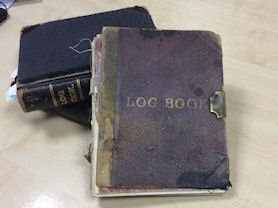 |
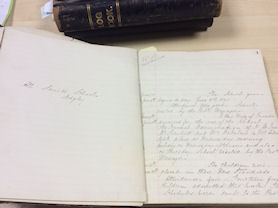 |
We are lucky enough to have old log books in school. These were record books kept by the Headteacher of the day-to-day events in the school. The earliest log book starts in June 1890. They give a very clear idea of what education was like at this time.
Travel to School
Children had to walk to school, often from a great distance and the log books frequently record: 'Children dried their clothes and went home.' (January 1901)
Heavy rain, snow storms and hop-picking all resulted in poor attendance: 'Seventy-five scholars absent this morning May 9th on account of heavy rain.' (May 1894)
Illness
Childhood illnesses frequently became epidemics, with measles, whooping cough, scarlet fever and mumps being common. Incidents of children with diphtheria are recorded when whole families had to be kept at home for six weeks. The Health department would step in: 'The numbers have been so small owing to the spread of disease that today we close school for three weeks by order of the Medical Officer of Health.' (12 November 1896)
Resources
The school was well equipped with up-to-the minute resources: 'New reading books, drawing slates, maps of the British colonies and geographies of the same were received this week.' (September 1891).
Educational Visits
Visits were made to Dudley Castle: 'The castle was reached at 2.20pm. After a rest of 10 minutes the actual work was started and proceeded with just one short break whilst a poem was read by the guns – Charge of the Light Brigade – until 4.30pm. The tram was boarded at 5pm.' (17 October 1913)
A visit for the younger pupils to Beacon Hill was also undertaken: 'Start made at 2.45pm one or two short stops made to ascertain position of sun direction etc. Country to the west of the Beacon observed and contrasted with country to East. Then children taken to top of monument in fours where contrast still more striking.' (22 October 1913)
An HMI Report from 14 April 1920
“The Headteacher has teaching ability above the average and with a higher aim than is usual in schools of this type. She has the power of awakening keen enthusiasm in her assistants and scholars alike, and the effect of this is very noticeable in the school. The children make real effort and show not only good actual results in their work, but what is more important they show a keen desire for further knowledge.
There is nothing mechanical or stereotyped about the methods in use. In every subject dealt with there is evidence of thought on part of the teacher combined with the effort to draw out the intelligence and reasoning power of the children. Self-reliance and self-effort are carefully cultivated and as a result the children are not easily discouraged when faced with some unusual form of question.
The ordinary formal subjects of Reading, Arithmetic and Writing show results quite up to a good average; all the Written work is well set out, and accuracy reaches a high level. The teaching of English is carried further than in most schools, and the good result is noticeable both in speech and Written Composition of the children.
Drawing, particularly as to brushwork, is excellent. It is quite unusual to find such delicacy of treatment in schools of this type, but it is one of those evidences of refinement and taste which seem to be typical of the school.”
Report by A T Sammons, HMI
Memories by Mrs Brooks
Mrs Brooks was a pupil at St. Chad's in 1936, and a teacher at school in 1966. Read her fascinating memories of the school in the document below: